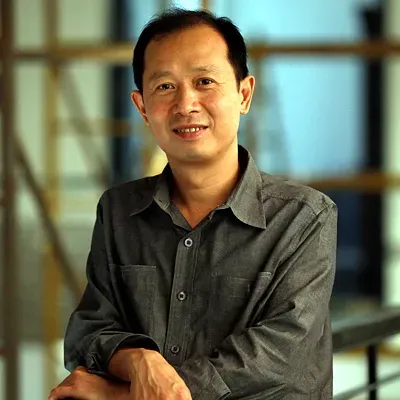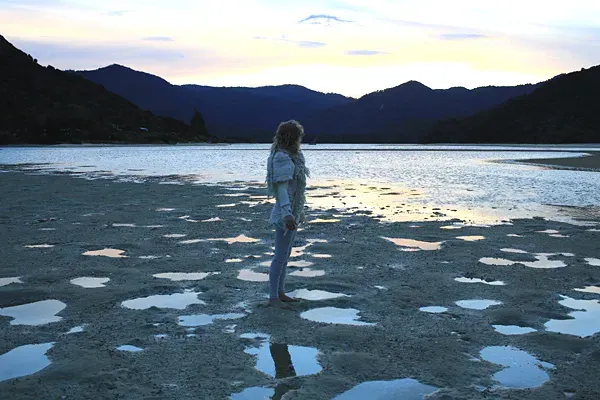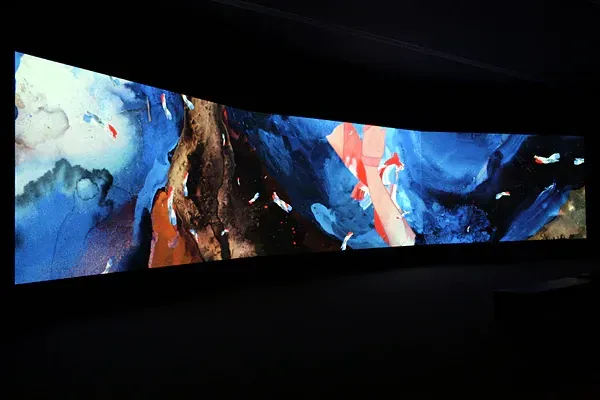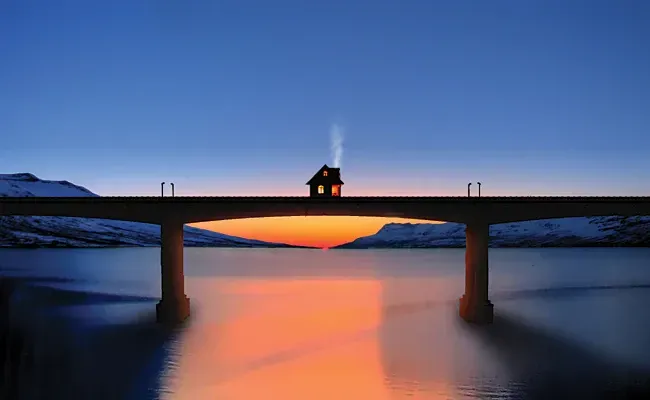If you were to live here...
Written by

Curator Hou Hanru tells Laura Howard about his approach to the 5th Auckland Triennial and how biennials and triennials are blossoming worldwide.
Curator Hou Hanru tells Laura Howard about his approach to the 5th Auckland Triennial and how biennials and triennials are blossoming worldwide.
"The regular critiques of their repeated-ness and lack of originality which also query the relevance of these often ‘over-globalised’ events and their seeming ignorance of local contexts seem to be legitimate – even unavoidable.
"Engaging artists and their work with the local geo-political-cultural conditions and local communities therefore becomes a necessity. We are determined to consecrate out art creation and engage ourselves in the specific locality where it takes place."
Hanru was born in Guangzhou, China, and has worked as a critic and curator in Paris and San Fransisco. He has previously curated major biennials including Lyon, Istanbul, and Guangzhou.
The 5th Auckland Triennial includes work by more than 30 New Zealand and international artists, collectives and architects and is now on at Auckland Art Gallery and eight additional sites around Auckland until 11 August.
What are some of the projects you have been working on prior to curating the Triennial?
Cities On The Move (1997–2000), Shanghai Biennale (2000), Gwangju Biennale (2002), Venice Biennale (French Pavilion, 1999, Z.O.U. - Zone Of Urgency, 2003, Chinese Pavilion, 2007), Nuit Blanche (2004, Paris), the 2nd Guangzhou Triennial (2005), the 2nd Tirana Biennial (2005), the 10th Istanbul Biennial (2007), Global Multitude (Luxembourg 2007), Trans(cient)City (Luxembourg 2007), EV+A 2008 (Limerick), The Spectacle of the Everyday, The 10th Lyon Biennale (Lyon, 2009), etc. He is currently curating the 5th Auckland Triennial (Auckland, New Zealand, May - August 2013).]
What’s your impression of New Zealand’s art scene?
There’s a freshness and a young spirit to much of what I have encountered of the New Zealand art scene. It’s open and active, with a lot of beautiful independent attitudes on the part of the artists. It differentiates itself from countries around it, including Australia, by negotiating a unique balance between Maori and Pakeha communities, and then more recently by an influx of people from around the Pacific Rim and the world.
There has been spectacular development here just like in many other places but I sense the country is a little less dominated by the economic model found elsewhere. There is a deeply-rooted insistence on an independent position.
The Asia Pacific art scene, in as much as it is one ‘scene’, shares that certain kind of freshness but in other ways consists of too many different countries and communities to be counted as one. Where there is a red line connecting the region, it is perhaps in the emergence of a new economic power within it, and the urbanisation and social change inherent in that.
It is important to emphasise of course that all of the countries have their own singular, unique context, underneath which are many layers of complex historical and social ‘complications’. This all leads, naturally, to very different outcomes, even between Australia and New Zealand, for example.
These interesting differences make the whole Asia Pacific region increasingly differentiated and diversified.
The 5th Auckland Triennial is titled If you were to live here... Can you expand upon your choice of title and theme, and why it is relevant for Auckland?
How to be in the world, or more precisely, how to ‘live here’, is the key question to start with when we engage in artistic production in making sense of life – to think through the meaning of living in the world with our imaginations and critical judgements, and to further figure out who we are. ‘To be here’ or ‘To live here’ provides the most basic but inevitable start for all our imaginations and artistic actions.
By calling the Triennial If you were to live here... we intend to emphasise the fact that the current Auckland Triennial – the fifth – is a locally engaged project of ‘global art’. We are determined to consecrate our art creation to, and engage ourselves with, the specific locality where it takes place.
The remote New Zealand, a faraway ‘there’ – and its self-mythologised bio-geological ‘virginity’ – can now been seen as ‘here’, a locality that is no longer situated on the margin of the world.
In New Zealand, the questions of dwelling and home and eventually the question of ‘here’ are intensely critical. As a postcolonial country, its existence relies on a cautiously kept balance between the colonisers (Pakeha) and the indigenous people (Maori) under the political-philosophical arrangement of biculturalism. Over time, this process formed a highly distinguished image of a nation, a kind of ‘official identity’. However, for the past couple of decades, new waves of immigrants from other Pacific nations, Asia, Africa and elsewhere have significantly altered New Zealand’s bicultural profile. The new lifestyles, cultures, values and modes of production brought into New Zealand by these immigrants and, equally importantly, the inevitable integration of the country into the globalised system of economic, cultural and political production and exchange, have made New Zealand a potential home for anyone in the world. Auckland has already seen its ‘nationals’ outnumbered by ‘foreigners’.
These global circulations of people birth to a new world: this is an open, unknown and perpetually evolving world that the traditional distinctions can no longer maintain and validate. New Zealand, as well as the Pacific region in which is situated, is now a central part of the new world system of multi-centres. The new routes of cultural and artistic production and circulation prove to be the best evidence of such a novel geopolitical cartography. The notions of belonging and home have fundamentally changed while new social divisions are being provoked.
It’s under such circumstances that an art event like the Auckland Triennial should be organised as a ‘home event’ in which the ‘global art community’ is invited to participate in the making and remaking of a ‘home’ – the Here. Imagine: “If you were to live here...”
Tell us about your curatorial approach, how you selected some of the artists and artworks?
There were not clear ‘guidelines’ as such. The research provided ideas for the theme, and related to that I had looked into the interaction between the local art community and the more international artists. Then came the consideration that the Auckland Triennial is not large – not as big as Sydney with over 100 artists, for example – but in the region of 30-40, so that provided another parameter to work within.
Meantime we also reached out to other professionals – architects, designers and so on, people who often lecturer in these topics – with the hopes of adding an educational dimension connecting the art community to all these others and the public.
Most of the artists respond directly and indirectly to the theme of home and evolution of habitation. So all this lead to an organic collection of the most appropriate participants.
Tell us about the Lab, and your decision to bring an ongoing performance aspect into the exhibition space in this way?
It’s vitally important to emphasise the Triennial is not only an exhibition. It is a site of production of knowledge and imagination, an alive, ongoing and infinite platform for dialogues, participations and exchanges between artists and the public, via collaborations with trans-disciplinary professionals and institutions. To realise such a vision, we have established a laboratory, The Lab, to occupy a central space at Auckland Art Gallery. This is the brain, the intellectual core of the Triennial. As a kind of open university, its programme – case studies, lectures, presentations, symposiums, panel discussions, performances and outside excursions – will unfold for the duration of the Triennial. A rich and intense programme around five major themes has been developed: Rural-Urban (as living space), Emergency Response and Recovery (Christchurch as a case study), Multicultural impacts on Urban Transformation, Ideal Homes and Informal Markets. The public is invited to participate on many levels, while students will develop case studies and presentations. General coordinator Michael Davis has also come up with a space design using an intelligent and efficient strategy to recycle the found materials in the Gallery – crates and frames, etc - to provide a flexible and stimulating space.
Ultimately this forms a space of occupation, a kind of ‘Temporary Autonomous Zone’ in the heart of the Triennial to allow and active and open discussion on the immediate and future social, urban and cultural reality in which we live. Mirroring the strategy of Occupy as a resistance to the hegemonic powers of the capital and its political alliances, along with arts projects at the Triennial, The Lab allows the most pressing questions of our time and our real lives to become the fuel for our intellectual and imaginative machines.
It’s like a volcano sitting in the centre of the whole Triennial event – one day it may explode, and the effect would be unexpectedly exciting!
It is great to see some of the city’s public spaces used as venues for the Triennial - for example Ryoji Ikeda’s sound installation at Silo 6. Can you tell us about your selection of sites for this Triennial?
The locations were chosen as a result of a lot of research on the city’s contemporary art scene, its architecture, and social and economic history. The idea was to reach out to many different partners and in connecting with a vast number of different contexts, to provide a more comprehensive picture of how the city evolved as it did.
Our venues are diverse. We’ve got the more traditional art spaces, typified by the likes of the Gus Fisher and George Fraser galleries, and of course the Auckland Art Gallery itself. Then, we have the Auckland War Memorial Museum, which provides a cultural and historical context to the examination of our theme. We really wanted to go beyond the central city and so Fresh Gallery in Otara was chosen - it’s been doing a great job in showcasing the work of Maori and Pacific artists of course, but also presenting an opportunity to effect change by inspiring viewers to reflect on issues that affect their lives. It’s a space that is not only defined by the parameters of the venue but also by the context and culture to which it belongs, investigates, inhabits and mediates.
Silo Park was another interesting venue. Situated on the waterfront, which represents the expansion and the renovation of the city and mirrors many such developments around the world, where industrial sites are being transformed into cultural equipment. While these developments are exciting and widely embraced, however, the speculation and gentrification involved are being critically debated. How to render this supposedly public space truly public?
In June, Maori architects Rau Hoskins and Carin Wilson plan to lead a collective that will erect a paparewa teitei (food storage construction) to host a festival on the waterfront – the first reconstruction of a paparewa teitei in the Auckland region in more than 150 years. It will be part of a festival of public creativity, which we hope will more genuinely put forward the Waterfront’s status as a public space than the area’s fancy restaurants.
What areas of the curatorial process do you find the most demanding? And rewarding?
The Auckland Triennial, now in its fifth year, is a small scale event (in the context of international events) and [has] confined funding. It’s also a funding structure that relies heavily on the existing structure of the Auckland Art Gallery. So those elements can be somewhat challenging.
On the other hand, I feel it has been a wonderful achievement that we have maintained professionalism in what we do but have also pushed the limits of what is possible. We’ve reached out to a wider geography but also engaged a huge range of very diverse groups of people; different social classes of people as well.
What are the most important aspects to work towards when putting together an exhibition?
Biennials, Triennials and similar events are blossoming everywhere in the world. The regular critiques of their repeated-ness and lack of originality which also query the relevance of these often ‘over-globalised’ events and their seeming ignorance of local contexts seem to be legitimate – even unavoidable. Engaging artists and their work with the local geo-political-cultural conditions and local communities therefore becomes a necessity. We are determined to consecrate out art creation and engage ourselves in the specific locality where it takes place.
Why is the form of the triennial important, and how do you think public exhibitions like biennials and triennials have changed in recent years?
Certainly there are an increasing number of biennials and triennials and the question of whether there are too many depends on how effectively they work to create relevance and a relationship with the public.
Generally they can work to raise the visibility of artistic events and endeavours and work to not only expose audiences to the best art from all over the world, but also encourage the best international artists to come and work and live in Auckland.
From a more global perspective, biennials and triennials work to broaden the scope of art seen by the public beyond the traditional centres, beyond the traditional institutions and contexts where art is produced, seen and perhaps even brought in the western tradition. The majority of the most exciting art is coming from Asia Pacific, Africa, Latin America, the Middle East and so forth – biennials and triennials provide a new form of cultural infrastructure that seeks these works out and helps to build a better consciousness of art in all its forms.
With relation to the Auckland Triennial, and connecting back into the theme of If you were to live here..., encountering others and merging onself in the concurrent rhizomes of diverse cultures, we learn to live anew and create a home for ourselves, a world in which ‘here’ and ‘there’ are intimately connected. Experimentations of different styles of living, of different methods of space production, are the driving force in this reinvention of the world. An artistic event like this Triennial has the vocation to become a platform for this type of experimentation.
How do you keep up-to-date with the art world outside of the major art centres? Is this important?
It is important, and luckily global communications networks make the flow of information much easier than ever before. On top of that travel is, of course, important – I like to meet people within the communities in which I curate and feel the connection with the context in which they work.
Having said that, every person can only do so much so I would never consider myself totally informed – everyone has a limit to how much they can do. And each territory in which art is created is so very different requiring a lot of work to understand comprehensively.
What are some new areas in which contemporary artists are heading?
That’s a very challenging question. The areas in which we find this triennial and much contemporary art exploring are things like experimental collaborations, research and educational experiences, different communities, and public spaces.
These aren’t exactly new – they have been done by different people for a while now but what is important now is the articulation of what we are doing; articulating the connection between art, history, education, research and all the other disciplines. That is what The Lab at the Triennial is all about.
The contemporary art world is often dominated by the market, by institutional recognition – even by fashion, in a sense. But it seeks to have a much deeper social and cultural engagement with communities.
What would you like audiences to take away with them from the 5th Auckland Triennial?
The answer to this very much depends on the individual audience, but if I could expect something from that experience it would be that the audience gets the central point of the project: that there can be new ways of conceiving and constructing our dwelling – hence our social stance – in the accelerated movements of everything, including our own bodies, across the globe. A related question: How utopian can you be about the way you live?
What’s your big idea for 2013?
I have a great expectation that I will have an even better idea for the year – but that better idea hasn’t come yet!


